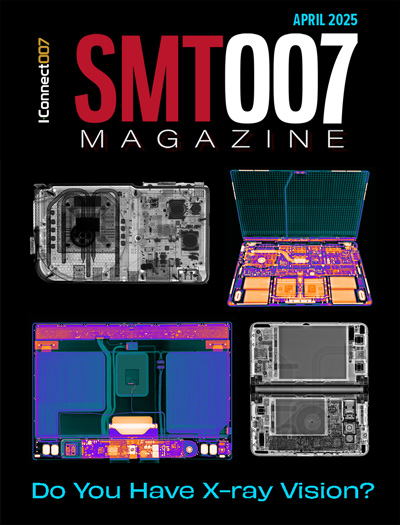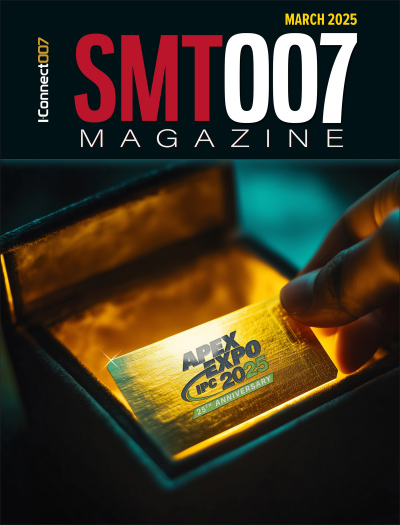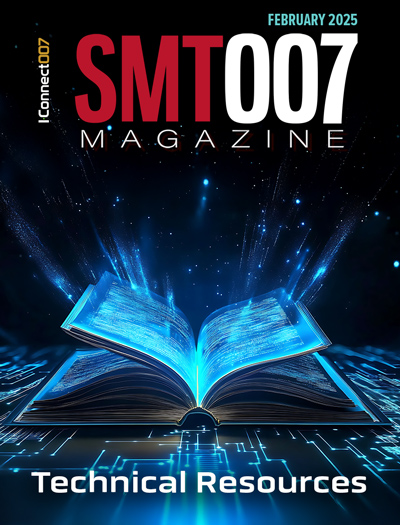-

- News
- Books
Featured Books
- smt007 Magazine
Latest Issues
Current Issue
Do You Have X-ray Vision?
Has X-ray’s time finally come in electronics manufacturing? Join us in this issue of SMT007 Magazine, where we answer this question and others to bring more efficiency to your bottom line.

IPC APEX EXPO 2025: A Preview
It’s that time again. If you’re going to Anaheim for IPC APEX EXPO 2025, we’ll see you there. In the meantime, consider this issue of SMT007 Magazine to be your golden ticket to planning the show.

Technical Resources
Key industry organizations–all with knowledge sharing as a part of their mission–share their technical repositories in this issue of SMT007 Magazine. Where can you find information critical to your work? Odds are, right here.
- Articles
- Columns
Search Console
- Links
- Media kit
||| MENU - smt007 Magazine
Understanding Conduction Soldering
December 31, 1969 |Estimated reading time: 9 minutes
By Jay Boyd, OK International
Manual soldering has been used for electronics assembly processes for over seven decades. Yet, even today, poor practices still create problems with reliability and efficiency. Poor hand soldering costs electronic manufacturers. There is no secret to producing a good solder joint; the challenge comes with repeating this feat. This article relates facts, fiction, and best practices of conduction soldering.

Poor hand soldering results are costing electronic manufacturers every year. There is no secret to producing a good solder joint; the challenge comes with repeating this feat for all joints in the assembly, at production speeds.
The characteristics of a good solder joint are well understood, and established soldering standards such as IPC J STD-001 provide an accurate guide to achieving satisfactory results. Production departments still frequently experience yield and throughput deficiencies equating to more than the cost of employing an additional operator. Finding a solution makes an appreciable difference to business performance.
Understanding hand soldering will help to establish a robust and consistently repeatable soldering process, resulting in lower defect rates and lower cost of ownership (COO). Factors include optimizing the flow of energy from the soldering iron to the joint, and then understanding how performing multiple soldering operations in rapid succession can alter this flow. With this knowledge, the relevant equipment performance parameters can be assessed. The results will surprise most operators, and make the link between speed and COO.
Tip/Heater Interplay
During conduction soldering, energy is transferred into the connection from the soldering iron, raising the joint to a suitable soldering temperature. The IPC and other, proprietary standards based on its recommendations, specify 40°C above the solder alloy’s melting point as suitable. Best practice is to keep the iron on the joint for 2?5 sec. This accepted methodology produces a solder joint that has an intermetallic layer of around 1-μm thickness, considered optimal for electrical performance and physical reliability. Figure 1 focuses on energy transfer as the mechanism that drives temperature rise. This analysis will help to demonstrate how the properties of the soldering iron influence the formation of a series of solder joints.
 Figure 1. Contact percentage from solder iron to PCB pad directly affects thermal performance.
Figure 1. Contact percentage from solder iron to PCB pad directly affects thermal performance.
When the soldering iron tip first comes into contact with the pad, thermal energy stored in the tip is transferred to the site of the joint. As this stored energy is dissipated, the soldering iron heater becomes the main source for the necessary energy to form the joint. Efficient delivery of heater energy, through the main body and face of the tip, will lead to rapid melting of the solder alloy as its temperature increases.
This energy-flow model highlights two important aspects of the soldering iron’s performance. First, the thermal properties of the tip — including mass, dimensions, and constituent materials — are crucial in delivering heater energy to the soldering site. Second, the heater must respond to the sudden application of a thermal load, so that the joint can reach recommended temperature quickly and smoothly without experiencing excessive temperature drop or overshoot. A range of commercial soldering irons will show an appreciable difference between indicated temperature and actual tip temperature during creation of a solder joint. This can prevent operators from meeting the conditions recommended in applicable soldering standards, risking substandard or rejected joints.
Tip Characteristics
Size and shape of soldering iron tip immensely influence heat-transfer efficiency. If the tip has low thermal mass compared to that of the joint, the amount of stored energy will be low; the initial temperature rise slow. If the face size cannot ensure a suitable contact area with the solder joint, the transfer of stored energy and heater energy will be impaired, slowing the rate of temperature rise. For example, choosing an incorrect tip that maintains only 50% contact with the joint results in failure to reach IPC-recommended soldering temperature (Figure 1). During the heater-power phase, tip length and width will determine how efficiently heater energy is conducted to the tip face.
If the tip is long and thin, with low thermal mass, and having a small face size compared to the joint, its ability to deliver thermal energy to the site will be low, ultimately resulting in slow joint formation. An over-large tip is not desirable: excessive stored energy may damage the PCB pad, and a face size that is too large may result in bridging. Selecting a suitable tip size for the operation at hand enables operators to produce large numbers of acceptable solder joints at high throughput (Figure 2).
 Figure 2. Conductivity factor (CF) quantifies the thermal energy transfer capability of a given tip geometry.
Figure 2. Conductivity factor (CF) quantifies the thermal energy transfer capability of a given tip geometry.
The tip-plating thickness also has an appreciable effect on energy transfer. A thick plating may be applied to extend tip lifetime, but it will influence thermal conductivity negatively. Tip shape also affects thermal performance. Some tips are unnecessarily stylized with various flats, step-downs, and constrictions along the length. In some cases this serves some minor functional purpose, but generally it actually restrict tips’ thermal performance.
The best possible tip shape is not excessively long, is smoothly tapered, has a chisel-shaped face that should be matched in size to the joint, and does not wear excessive plating thickness. It should have sufficient mass to deliver necessary energy into the thermal load to raise the solder alloy above its melting point within an acceptable time.
Many operators expect to use only one size and type of tip while soldering. In practice, choosing a different tip for certain tasks will accelerate production of good joints.
Heater Control Strategy
Assuming the operator chooses the optimum tip for a given sequence of soldering tasks, solder joint formation relies on effective management of heater power. Bearing in mind the role of the tip, implementing a heater of higher wattage — rather than setting a higher tip temperature — is the most effective way to raise the solder to a molten state quickly. In this formation, the tip will experience a smaller temperature drop when applied to the load, and will recover its normal operating temperature more quickly after completion. Both factors are important if operators are to produce large numbers of high-quality solder joints in rapid succession.
Ensuring adequate heater power for a given range of soldering tasks is requisite. However, controlling that power is vital if other hazards, such as damaging thermal overshoot, are to be avoided.
If a heater has a fixed power rating, this impairs its ability to provide suitable control. It operates only at its rated power to maintain the preset tip temperature as energy is transferred from tip to joint. A tip-temperature sensor, due to its location in the iron’s body, always suffers some inherent lag as the tip temperature fluctuates.
A soldering iron station with built-in digital temperature meter seems to offer a solution. The user can preset operating temperature and test that the tip matches this preset value by touching against a test point. Production managers assume that this offers a satisfactory assurance of correct soldering iron adjustment, and expect that the tool will deliver repeatable performance on the factory floor. In fact, the load placed on the soldering iron during such a test is lower, appreciably, than that imposed during a soldering operation. The static test, in practical terms, simply confirms the calibration of the tip temperature sensor against that of the test sensor.
Under thermal load, a typical tip’s temperature markedly diverges from that indicated by the digital temperature gauge. Fitting a thermocouple close to the end of the tip and recording its response in relation to the digital temperature gauge during a soldering operation illustrates this assertion. There is a large drop in actual tip temperature as the tip contacts the joint. The instrument’s digital temperature indicator fails to show it. This test also relates an appreciable temperature overshoot as the heater control overcompensates for the temperature fall. Temperature overshoot carries the potential to damage the board or component, and in any case indicates below-optimal process control. Recommended temperatures and time periods indicated in standards do not consider such detrimental oscillations.
Manage Energy, Not Temperature
The key lies with the fact that temperature-controlled soldering irons are not designed to manage thermal energy. Instead, the heater, usually ceramic, is turned on if the embedded temperature sensor reads too high, and off if the sensor reads too low. In practice, when the heater controller receives the signal to turn on the heater, the tip temperature already will have fallen below its set point. The heater then is run at maximum power to increase tip temperature, invariably causing temperature overshoot.
An alternative to conventional thermostatically controlled heaters, inductive heating enables maximum tip temperature to be governed without temperature-sensing or control circuitry. An inductive heater suitable for use in a soldering iron comprises a copper slug coated with magnetic material, wound about with a current-carrying coil. Magnetic coating properties dictate how its Curie temperature coincides with the preset maximum temperature for the soldering iron. At this Curie temperature, the coating loses its magnetic properties, causing the inductive heating action to cease. Slug temperature never can overshoot this natural maximum. When iron contact a joint, applying thermal load, the slug falls below the Curie temperature; the coating begins to reacquire magnetic properties. Inductive heating is reactivated. In this way, an inductive soldering-iron heater operates without a temperature sensor or control circuitry, and recommences supplying thermal energy automatically, as soon as the tip contacts the joint. Tip temperature is capped effectively, never overshooting the preset maximum.
Speed and Cost
Consider a soldering comparison betweenconventional and inductive soldering irons. Thermocouples inserted into the tips of both, close to the tip face, monitor tip temperatures continuously and in real time to compare time-to-completion on a series of nine solder joints (Figure 3). The conventional soldering irons need progressively longer dwells to regain temperature presets as the test runs. The enhanced energy-management capabilities of the inductively heated iron enable a more consistent production rate.
 Figure 3. Soldering irons form nine joints in succession to test tip idle; the inductively heated system is fastest by 18%.
Figure 3. Soldering irons form nine joints in succession to test tip idle; the inductively heated system is fastest by 18%.
The slowdown in joint production over the course of this demonstration translates into a significant loss of productivity, leading to higher costs for production operators. Assume an operator works 2,000 total hours in 50 40-hour working weeks per year, and that 30% of that time is spent hand soldering. This equates to 600 hours of soldering time using the fastest iron described in Figure 3. Since the next fastest tool is 18% slower, the operator will use an extra 108 hours to complete the same work. Assuming cost of labor at $14.50/hour (depending on geographical location), this corresponds to about $1,700. If 10 operators are employed, all using the slower equipment, the cost to the corporation is about $17,100.
The same estimate applied to the next-slowest soldering iron reveals an even larger loss. Since this unit is 39% slower, the extra cost of having 10 operators working at this enforced lower rate will be almost $33,800.
This calculation shows that businesses can recoup quickly the larger capital investment in inductively heated irons to acquire better performance. In some cases, the savings exceed the cost of an additional operator. Going further, to consider the total COO, including the consumables and lost productivity due to unsatisfactory production quality, under-powered soldering irons displaying poor energy control represent an even greater cost to the enterprise.
Conclusion
Controling soldering temperature in a practical production or repair environment, where high throughput and productivity are required, requires fast and efficient transfer of thermal energy. This can be achieved through optimum tip selection and accurate management of heater power without exceeding temperatures recommended in established soldering standards.
Jay Boyd, global product marketing manager, OK International, may be contacted at jboyd@okinternational.com.


